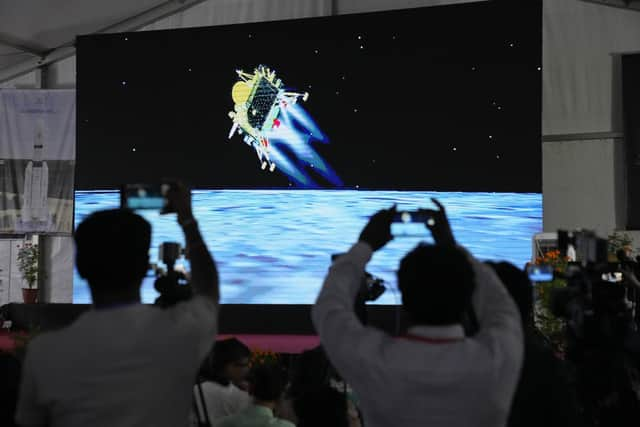Chandrayaan-3: hopes of waking Indian Moon lander weaken as scientists await signal
and live on Freeview channel 276
India's scientists have been unable to re-awake its Moon lander after it went into shutdown mode to survive the lunar night conditions.
The Chandrayaan-3 mission made a historic landing on the moon's south pole in August, after 40 days travelling to the Moon, and spent a week collecting data from its surface.
Advertisement
Hide AdAdvertisement
Hide AdThe mission saw the rover moving at slow speeds of around 10cm (4in) per second. It had detected the “unambiguous” presence of sulphur and other elements and continued to look for signs of frozen water on the lunar surface.


During its time on the Moon, it had also recorded a seismic event which Isro said on 31 August was “under investigation”.
Another instrument made the first-ever measurements of the plasma environment over the south pole surface.
The Vikram lander and Pragyan rover had been put into "sleep mode" to protect the electrical components as lunar night conditions can see temperatures drop to -250 degrees Celsius and last for two weeks.
Advertisement
Hide AdAdvertisement
Hide AdIsro said they were confident Vikram and Pragyan would awake on 22 September, after the sun would re-appear and its solar panels could be recharged.
However, Isro have been unable to make contact with the robots, and said: "hopes are dimming” for their revival. According to the scientists, there is around a 50% chance the devices could endure the freezing temperatures.
“Efforts to establish communication with the Vikram lander and Pragyaan rover will continue,” said ISRO on X, formerly Twitter, on Friday (22 September).
Former Isro chief AS Kiran Kumar told the BBC on Monday (25 September) that chances of the rover and lander awakening are “dimming with each passing hour”.
Advertisement
Hide AdAdvertisement
Hide Ad“Unless the transmitter on the lander comes on, we have no connectivity. It has to tell us that it’s alive. Even if all other sub-systems work, we have no way of knowing that,” Mr Kumar said.
The team said they would continue efforts to make contact with the spacecraft until 30 September - which is when the next lunar sunset is scheduled.
However, even if the robots do not wake up, Irso has emphasised that the Chandrayaan-3 mission had already been a major success and achieved its main objectives. “If Vikram and Pragyaan do not wake up they will stay on the moon as India’s lunar ambassador,” they said.
Comment Guidelines
National World encourages reader discussion on our stories. User feedback, insights and back-and-forth exchanges add a rich layer of context to reporting. Please review our Community Guidelines before commenting.
